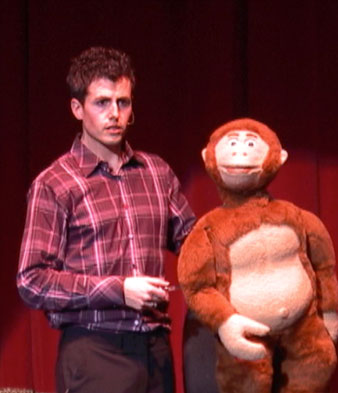With 26 years of experience as a professional ventriloquist, I’ve been through about every training that exists. Also, I’ve met most of the ventriloquists who are household names.
Here’s the definitive answer to whether ventriloquists throw their voice:
Ventriloquists do not actually throw their voice. Instead, they create the illusion that their voice is being “thrown.”

It is important to note that there are two ways a ventriloquist creates this illusion. One is called near ventriloquism, the other is distant ventriloquism. We’ll take a quick look at what each of these is.
Near Ventriloquism
When a ventriloquist makes a puppet or dummy talk, this is considered near ventriloquism. Because the object is next to them, and they are creating the illusion that the voice is coming from it.
No special voice skills are required to pull this off – besides not moving ones lips and also moving the puppet to make it look lifelike.
All of our lives, we have seen a correlation between someone’s mouth moving, and a voice coming from their mouth. When we hear a voice and see a puppet’s mouth move – even though it is a few feet from where the source of the voice, our brain automatically tells us the voice is coming from the puppet. The illusion is created automatically.
Distant Ventriloquism
This is where a ventriloquist creates the illusion that a voice is coming from a source quite distant from the ventriloquist. As it may go without saying, some serious magic is required to successfully pull this off.
Compared to near ventriloquism, this can be more difficult.Of course, I’m not downplaying the high level of skill required for near ventriloquism. After all, speaking without moving your lips, plus making an inanimate object look lifelike is quite a feat!
Back to distant vent (short for ‘ventriloquism’). From an audience’s perspective, a voice seems to be coming from an attic, as an example. In reality, it is coming from the ventriloquist.
Half the challenge is altering one’s voice to make it sound like another person’s voice coming from another location. The other half is leading the person to believe it is coming from that source.
In near ventriloquism, an audience member’s brain is telling them the voice is coming from the puppet in their plain sight. In distant ventriloquism, the ventriloquist’s non-verbal or verbal response to the voice is what creates the illusion.
This could be as simple as the ventriloquist’s body language showing shock by jumping away from the fictitious source of the voice when they hear it.
Examples of Near Ventriloquism
Over the last few years, three ventriloquists have America’s Got Talent using near ventriloquism. Terry Fator, Darcy Lynne and Paul Zerdin all made puppets in their possession talk.
Another is Comedy Central start Jeff Dunham. His use of near vent to make Walter (crank old guy), Bubba J (hillbilly), Peanut (purple thing) and Achmed of “I keel you” fame talk has made him a millionaire many times over.

Examples of Distant Ventriloquism
Althought AGT winner Paul Zerdin primarily made puppets in his possession talk, there were some bits where he made a puppet of a baby cry who was some distance from him. The puppet was in a baby carrier facing away from the audience, while Zerdin was standing above the baby carrier.
On a personal note, whenever I’ve tried to incorporate distant ventriloquism into my routine, at open mic’s I was told that it didn’t sound like a voice was coming from the attic. Instead, it apparently sounded like I was constipated. Yikes! 😂
I believe most anyone could learn distant ventriloquism if they were willing to put in the time and effort. Thus far, I obviously haven’t been motivated enough to do so myself.
Whether a ventriloquist is throwing their voice into a puppet nearby, or an object far away, they are not throwing their voice. It is the incredible illusion that leads the audience to believe the voice is being “thrown.”

